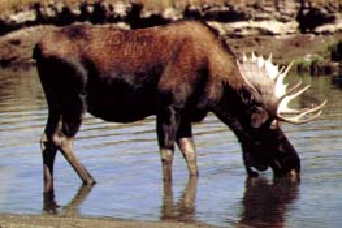Travel Reference
In-Depth Information
Moose
The largest member of the deer family,
moose
(Alces alces shirasi)
—confusingly called
elk
in Europe— are relatively rare in Yellowstone, probably fewer than one hundred, so seeing one
is a treat. The 1988 fires caused a decline in moose population mostly due to the loss of the
old-growth forest they depend upon in winter. Watch for an ungainly, large, dark brown an-
imal—if it's a mature bull, it will have distinctive
palmate
antlers; that is, shaped like the palm
and fingers of a hand. Both bulls and cows have a dewlap of hanging skin under the throat.
They eat willows and other plants that grow in shallow water all summer, but when snow is
deep, they move high up to browse on fir trees.
The buffalo, more properly called the
bison
(Bison bison),
symbolizes the wide open spaces
of the American west. Ironically, the bison is also probably the most grievous case of man's
wanton destruction of a natural resource in America's history. Not only did hunters nearly
eradicate the bison during the last decades of the nineteenth century, but the slaughter was
actually encouraged by the government to suppress the Native American Indians who depen-
ded upon them.
Yellowstone's herd is sometimes called the only surviving wild population of bison.
Though not fenced in, they are not genetically the same wild bison as when the park was new.
The few bison left by 1900 were crossbred here with semi-domesticated animals from Texas
and northern Montana in an early successful effort to undo damage to the environment. The
restoration of the bison proved so successful, in fact, that by 1940 the park was giving them
away to zoos.

